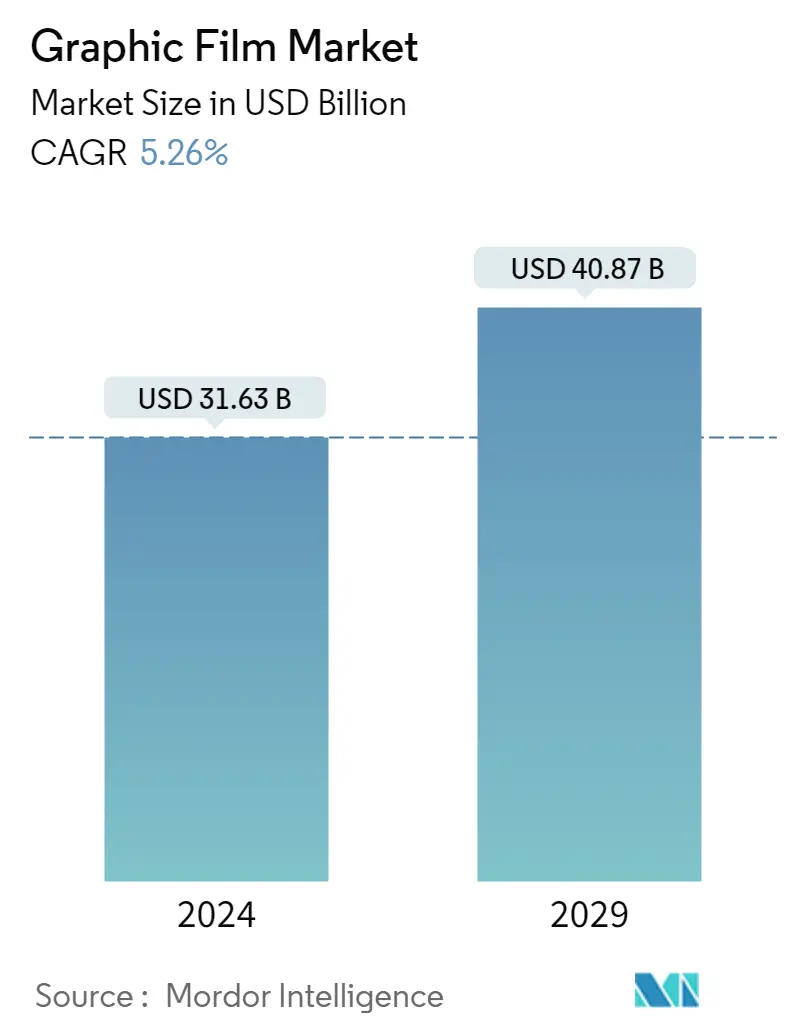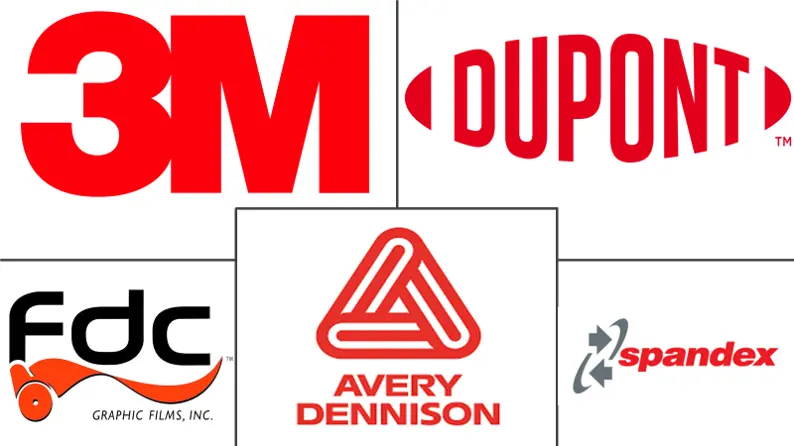
| Study Period | 2019 - 2029 |
| Market Size (2024) | USD 31.63 Billion |
| Market Size (2029) | USD 40.87 Billion |
| CAGR (2024 - 2029) | 5.26 % |
| Fastest Growing Market | Asia Pacific |
| Largest Market | Asia Pacific |
| Market Concentration | Low |
Major Players
*Disclaimer: Major Players sorted in no particular order |
Graphic Film Market Analysis
The Graphic Film Market size is estimated at USD 31.63 billion in 2024, and is expected to reach USD 40.87 billion by 2029, growing at a CAGR of 5.26% during the forecast period (2024-2029).
The impact of the COVID-19 pandemic on the market studied is hindering the overall anticipated growth rates. However, with contingency strategies and major end-user industries gaining gradual momentum, the long-term demand forecast demonstrates a significant surge in sales. With demand steadily growing and companies recuperating from the losses incurred due to the pandemic, the ancillary demand for graphic film wraps used in the automobile sector is anticipated to rise linearly in the short-term forecast of the market studied. Furthermore, according to Indian Rating and Research Private Limited (IND-RA), the plastic film demand rose close to 9% in 2020 and is expected to fall to 6-6.5% by 2023.
- Several market incumbents are manufacturing perforated window films that are designed for use on flat, transparent surfaces, such as glass windows or doors. These films are usually equipped with a continuous hole pattern perforated into the film to provide graphics visible from one side.
- Window film is essentially a thin laminate with an adhesive backing that is added to either the inside or outside of a window. It can be cut into almost any design and applied to windows or doors for various purposes - from printing corporate logos and marketing to designing fully customized walls. Window films offer privacy and protection against UV rays and even help manage thermoregulation of interiors, like corporate workspaces. Window films can be retrofitted to existing windows, which makes them an economical and speedy option.
- Wall and window graphics transform consumer experiences with interior and exterior designs. Several offices are incorporating graphic films to maximize their branding, promote new products and sales, improve workplace productivity and morale, entertain and inform customers, and enhance the corporate environment.
- Indoor wall wraps are gaining market traction, as most corporate buildings are redesigning their workspaces with these products. These wall wraps turn smooth indoor surfaces into artworks with a wide array of graphic films. Further, market players are capitalizing on this lucrative opportunity by offering printable films and finishes to colored films and other ancillary products, thus boosting their overall revenues.
- Graphic films are also used as paint protection films to protect the exterior components of vehicles for lowering the maintenance cost. The rising demand for graphic films to safeguard vehicles and for advertising in developed and developing economies may augment graphic films' growth in the automotive sector. For instance, US-based Mactac launched a new adhesive vehicle wrap for vendors looking to advertise their products and brands on trucks, buses, vans, and other vehicles.
- As per the company, the new proprietary adhesive enhances the ease of application of wraps. This easily-removable adhesive backs a gloss white soft calendered PVC film, which is highly suitable for color reproduction, and a poly-coated liner for stability during printing.
Graphic Film Industry Segmentation
A graphic film has a sheet or layer made of polymer compounds. It is applied to the surface for protection from weather conditions with promotional intentions. The report on the graphic film market studies different polymeric films used for printing images or visual representations on the film's surface to share information. Graphic films are used in various end-user industries, such as automotive, institutional, promotional, and advertising, to create unique appearances to enhance the material or object. The market is segmented by different geographies, such as North America, Europe, Asia-Pacific, and the Rest of the World. Further, the study also covers the impact of COVID-19 on the graphic film market in different regions.
| Polypropylene (PP) |
| Polyethylene (PE) |
| Polyvinyl Chloride (PVC) |
| Other Polymers |
| Automotive |
| Promotional & Advertisement |
| Institutional |
| Other End-User Industries (Aircraft Industry and E-commerce) |
| North America |
| Europe |
| Asia Pacific |
| Rest of the World |
Graphic Film Market Size Summary
The graphic film market is poised for significant growth over the forecast period, driven by increasing demand across various end-user industries such as automotive, industrial, and e-commerce. The market is characterized by a fragmented and highly competitive landscape, with major players like 3M Company, Avery Dennison Corporation, and E.I. Du Pont De Nemours and Company leading the charge through product innovation and strategic mergers. The market's expansion is supported by the rising adoption of graphic films for applications such as vehicle wraps, window films, and wall graphics, which offer benefits like UV protection, privacy, and enhanced branding opportunities. The automotive sector, in particular, is witnessing a surge in demand for graphic films due to their cost-effective advertising potential and protective qualities.
Regionally, Asia-Pacific is expected to hold a prominent share, with China and India playing crucial roles due to their burgeoning automotive and construction industries. The Chinese government's focus on expanding its automotive output and the rapid development of the advertising industry are key factors contributing to the market's growth in the region. Similarly, India's construction market is experiencing rapid expansion, driven by urbanization and increased disposable income, which is expected to create further opportunities for graphic films. As companies recover from the pandemic's impact, the market is anticipated to see a steady rise in demand, with innovations such as reflective films and printable finishes enhancing the product offerings and driving revenue growth.
Graphic Film Market Size - Table of Contents
1. MARKET DYNAMICS
-
1.1 Market Drivers
- 1.1.1 Growth in the Construction Industry and Improvements in the Standard of Living
- 1.1.2 Growth in Demand for Wrap Advertisement
-
1.2 Market Restraints
- 1.2.1 Fluctuations in Raw Material Prices
2. MARKET SEGMENTATION
-
2.1 Polymer
- 2.1.1 Polypropylene (PP)
- 2.1.2 Polyethylene (PE)
- 2.1.3 Polyvinyl Chloride (PVC)
- 2.1.4 Other Polymers
-
2.2 End-User Industry
- 2.2.1 Automotive
- 2.2.2 Promotional & Advertisement
- 2.2.3 Institutional
- 2.2.4 Other End-User Industries (Aircraft Industry and E-commerce)
-
2.3 Geography
- 2.3.1 North America
- 2.3.2 Europe
- 2.3.3 Asia Pacific
- 2.3.4 Rest of the World
Graphic Film Market Research FAQs
How big is the Graphic Film Market?
The Graphic Film Market size is expected to reach USD 33.29 billion in 2025 and grow at a CAGR of 5.26% to reach USD 43.02 billion by 2030.
What is the current Graphic Film Market size?
In 2025, the Graphic Film Market size is expected to reach USD 33.29 billion.


